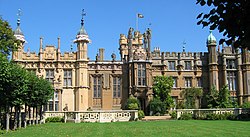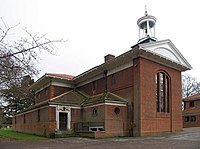Knebworth
| Knebworth | |
| Hertfordshire | |
|---|---|
 Knebworth House | |
| Location | |
| Grid reference: | TL252201 |
| Location: | 51°51’58"N, 0°11’2"W |
| Data | |
| Population: | 0 (est.) |
| Post town: | Stevenage |
| Postcode: | SG3 |
| Dialling code: | 01438 |
| Local Government | |
| Council: | North Hertfordshire |
| Parliamentary constituency: |
Stevenage |
Knebworth is a village in northern Hertfordshire, found immediately south of Stevenage but having escaped the clutches of New Town development and its urban sprawl.
The civil parish of Knebworth covers an area between the villages of Datchworth, Woolmer Green, Codicote, Kimpton, Whitwell, St Paul's Walden and Langley, and encompasses the village of Knebworth, the small village of Old Knebworth and Knebworth House.
Knebworth House
Knebworth House is a dominating presence in the area. A grand house in magnificent grounds, it has been the home of the Lytton family since 1490, when Thomas Bourchier sold the reversion of the manor to Sir Robert Lytton. The house is opened to the public for most of the year.
Knebworth House was originally a genuine red-brick Late Gothic manor house, built round a central court as an open square. In 1813-16 the house was reduced to its west wing,[1] which was remodelled in a Tudor Gothic style by John Biagio Rebecca for Mrs Bulwer-Lytton,[2] and then was transformed in 1843-45 by Henry Edward Kendall, Jr. into the present “Tudor Gothic” structure.[3].
The most famous resident of Knebworth House was Edward Bulwer-Lytton, the Victorian author, dramatist and statesman, who embellished the gardens in a formal Italianate style. Much of the interior was redesigned by Sir Edwin Lutyens, who simplified the main parterre. A herb garden in an interlaced quincunx design was drawn by Gertrude Jekyll in 1907 but not planted until 1982.
Many special events are held at Knebworth House throughout the year. Since 1974 Knebworth House held numerous major open air rock and pop concerts, and the name of Knebworth is now famous for that reason.
Churches
- Church of England:
- St Mary's, parts of which date back to 1120
- St Martin’s; designed by Sir Edwin Lutyens and consecrated in 1915
- Methodist and United Reformed Church: Trinity Church, built in 1996 with roots back to 1880
- Roman Catholic: St Thomas More, built in 1936
St Mary's stands within the grounds of Knebworth House, but with separate, free access. The origins of this church go back 900 years. It has a fine collection of monuments, and some of the county's finest sculptures.
History
There is evidence of people living in the area as far back as Neolithic times but the village appeared in the Early Mediaeval period.
The manor of Knebworth is listed in the Domesday Book of 1086 as ‘’Chenepeworde’’, presumed to be the Old English ‘’Cneppanweorð’’ (“Cneppa’s farm”; Cnebba may be a Danish name). It then had a population of around 150. The original village, now known as Old Knebworth, developed around Knebworth House. Development of the newer Knebworth village started in the late 19th century centred a mile to the east of Old Knebworth on the new railway station and the Great North Road (subsequently the A1, and now the B197 since the opening of the A1(M) motorway in 1962).
- The Roebuck Inn, its oldest public house (now engulfed in Stevenage) dating back to 1420
- The Lytton Arms (in Old Knebworth) which is an early Victorian building
- The The Station public house which was built in 1883
Sport and leisure
Knebworth has a Non-League football club Knebworth FC who play at Knebworth Recreation Ground.
Outside links
| ("Wikimedia Commons" has material about Knebworth) |
- Knebworth Parish Church
- Amateur Dramatics:
- Sport:
- Neighbourhood Watch
- Parish Plan
- Primary School
- Village
- Knebworth House
References
- ↑ 'Parishes: Knebworth', A History of the County of Hertford: volume 3 (1912), pp. 111-18
- ↑ Colvin, Howard (1995) A Biographical Dictionary of British Architects 1600-1840, 3rd ed. New Haven: Yale University Press, s.v. "John Biagio Rebecca".
- ↑ Colvin, Howard (1995) A Biographical Dictionary of British Architects 1600-1840, 3rd ed. New Haven: Yale University Press, s.v. "Henry Edward Kendall", note.
